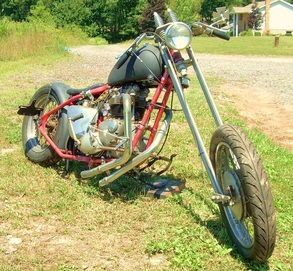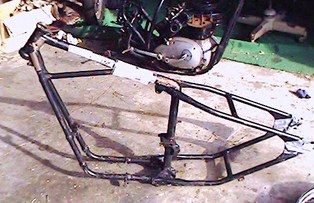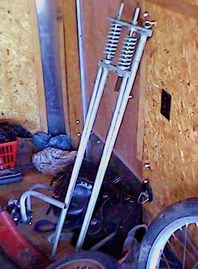1965 Triumph TR6 SR
Purchase Date: Spring 2003

Influenced by the current chopper craze in 2000, I wanted to build a low-budget hard-tail Triumph chopper of my own. This Rat Rod Trump was my solution.
I scoured the internet, searching for an inexpensive and running Trump. I came across a ‘65 TR6SR advertised as a Bonneville with a clean title and in running condition. I pulled the trigger on the eBay purchase for a good price. The following weekend I made the seven hour drive from Northeastern Pennsylvania to the bike’s location in Virginia.
The 1965 Triumph TR6SR is the hi-performance roadster version of the TR6. The bike has an overhead valve parallel twin engine. A single Amal Monobloc 389 carburetor delivers the air-fuel mixture top the 649 cc engine. Power output is 42 hp @ 6,500 rpm. The gearbox houses a four speed transmission with a wet multi-plate clutch. The weight is light at 363 lbs unladen. Gas tank fuel capacity is 2.5 gallons.
Most of the Whitworth hardware on the motorcycle was mangled, rusted or stripped. The frame was not the original and the Amal carburetor had battle scars. It was a salvageable motorcycle, but would take some work. I wanted a project and got what I asked for.
On a positive note, the cylinders had been previously bored out to a 750 with good compression. The transmission had good positive (right side) shifting, and the clutch had a strong pull.
I scoured the internet, searching for an inexpensive and running Trump. I came across a ‘65 TR6SR advertised as a Bonneville with a clean title and in running condition. I pulled the trigger on the eBay purchase for a good price. The following weekend I made the seven hour drive from Northeastern Pennsylvania to the bike’s location in Virginia.
The 1965 Triumph TR6SR is the hi-performance roadster version of the TR6. The bike has an overhead valve parallel twin engine. A single Amal Monobloc 389 carburetor delivers the air-fuel mixture top the 649 cc engine. Power output is 42 hp @ 6,500 rpm. The gearbox houses a four speed transmission with a wet multi-plate clutch. The weight is light at 363 lbs unladen. Gas tank fuel capacity is 2.5 gallons.
Most of the Whitworth hardware on the motorcycle was mangled, rusted or stripped. The frame was not the original and the Amal carburetor had battle scars. It was a salvageable motorcycle, but would take some work. I wanted a project and got what I asked for.
On a positive note, the cylinders had been previously bored out to a 750 with good compression. The transmission had good positive (right side) shifting, and the clutch had a strong pull.

Frame hunting was tricky. Frames are not only everywhere but also expensive and can be low quality or/and simply ridiculous looking. I was shopping on the cheap and had an idea what kind of stance I wanted for the roller. After searching high and low, I found an old frame that suited my needs on eBay. The frame came with a rusty bolt/weld on hard tail. I ground it down, cleaned it up and made it secure.
After many layers of thick, red, pearl paint and a dozen coats of clear coat, the frame was ready. If I were to do it again, I would save time and money by sending it out for a simple powder coating. The look of the frame worked out well for this build.
After many layers of thick, red, pearl paint and a dozen coats of clear coat, the frame was ready. If I were to do it again, I would save time and money by sending it out for a simple powder coating. The look of the frame worked out well for this build.

Next I searched for a front end within my budget. I wanted an old school springer style - long and skinny. I found one through a contact. After seeing a few low quality photos, I took a risk and made the purchase. Aside from the missing top springs, the springer ended up working out well. Luckily, I was able to find a set of top springs at a local bike barn that did the trick.
Here are a few of the updates I completed during the build:
Electronic Ignition: Installed Boyer Bransden electronic ignition and removed the points plate.
Rear Fender: The rear fender is an old Harley fender chopped up. I’m not sure what model it was from.
Seat: A simple solo seat with 3” springs from a local distributor. “Just something to sit on.”
Carburetor: Replaced the Amal with a new Mikuni.
Handle Bars: Reversed the Clubman bars.
Exhaust: A set of short straight pipes came as an extra with the original bike purchase.
Miscellaneous: New paint, hardware, chain, plugs, fluids, duct tape, zip ties, etc.
Looking back, if I had this Trump today I would have taken the build in a completely different direction. At the time this chop was killer.
Here are a few of the updates I completed during the build:
Electronic Ignition: Installed Boyer Bransden electronic ignition and removed the points plate.
Rear Fender: The rear fender is an old Harley fender chopped up. I’m not sure what model it was from.
Seat: A simple solo seat with 3” springs from a local distributor. “Just something to sit on.”
Carburetor: Replaced the Amal with a new Mikuni.
Handle Bars: Reversed the Clubman bars.
Exhaust: A set of short straight pipes came as an extra with the original bike purchase.
Miscellaneous: New paint, hardware, chain, plugs, fluids, duct tape, zip ties, etc.
Looking back, if I had this Trump today I would have taken the build in a completely different direction. At the time this chop was killer.
Sale Date: Fall 2005